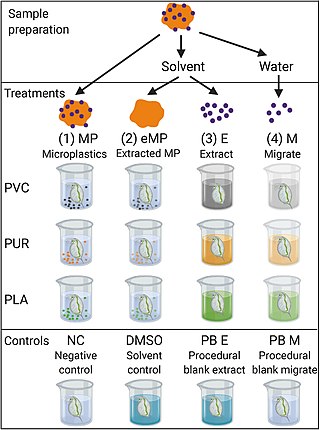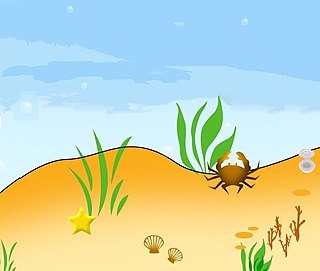
Water pollution is the contamination of water bodies, usually as a result of human activities, so that it negatively affects its uses. Water bodies include lakes, rivers, oceans, aquifers, reservoirs and groundwater. Water pollution results when contaminants mix with these water bodies. Contaminants can come from one of four main sources: sewage discharges, industrial activities, agricultural activities, and urban runoff including stormwater. Water pollution is either surface water pollution or groundwater pollution. This form of pollution can lead to many problems, such as the degradation of aquatic ecosystems or spreading water-borne diseases when people use polluted water for drinking or irrigation. Another problem is that water pollution reduces the ecosystem services that the water resource would otherwise provide.

Bioremediation broadly refers to any process wherein a biological system, living or dead, is employed for removing environmental pollutants from air, water, soil, flue gasses, industrial effluents etc., in natural or artificial settings. The natural ability of organisms to adsorb, accumulate, and degrade common and emerging pollutants has attracted the use of biological resources in treatment of contaminated environment. In comparison to conventional physicochemical treatment methods bioremediation may offer considerable advantages as it aims to be sustainable, eco-friendly, cheap, and scalable.

Phytoremediation technologies use living plants to clean up soil, air and water contaminated with hazardous contaminants. It is defined as "the use of green plants and the associated microorganisms, along with proper soil amendments and agronomic techniques to either contain, remove or render toxic environmental contaminants harmless". The term is an amalgam of the Greek phyto (plant) and Latin remedium. Although attractive for its cost, phytoremediation has not been demonstrated to redress any significant environmental challenge to the extent that contaminated space has been reclaimed.

Ecotoxicology is the study of the effects of toxic chemicals on biological organisms, especially at the population, community, ecosystem, and biosphere levels. Ecotoxicology is a multidisciplinary field, which integrates toxicology and ecology.

Mycoremediation is a form of bioremediation in which fungi-based remediation methods are used to decontaminate the environment. Fungi have been proven to be a cheap, effective and environmentally sound way for removing a wide array of contaminants from damaged environments or wastewater. These contaminants include heavy metals, organic pollutants, textile dyes, leather tanning chemicals and wastewater, petroleum fuels, polycyclic aromatic hydrocarbons, pharmaceuticals and personal care products, pesticides and herbicides in land, fresh water, and marine environments.

Nonpoint source (NPS) pollution refers to diffuse contamination of water or air that does not originate from a single discrete source. This type of pollution is often the cumulative effect of small amounts of contaminants gathered from a large area. It is in contrast to point source pollution which results from a single source. Nonpoint source pollution generally results from land runoff, precipitation, atmospheric deposition, drainage, seepage, or hydrological modification where tracing pollution back to a single source is difficult. Nonpoint source water pollution affects a water body from sources such as polluted runoff from agricultural areas draining into a river, or wind-borne debris blowing out to sea. Nonpoint source air pollution affects air quality, from sources such as smokestacks or car tailpipes. Although these pollutants have originated from a point source, the long-range transport ability and multiple sources of the pollutant make it a nonpoint source of pollution; if the discharges were to occur to a body of water or into the atmosphere at a single location, the pollution would be single-point.

Surface runoff is the unconfined flow of water over the ground surface, in contrast to channel runoff. It occurs when excess rainwater, stormwater, meltwater, or other sources, can no longer sufficiently rapidly infiltrate in the soil. This can occur when the soil is saturated by water to its full capacity, and the rain arrives more quickly than the soil can absorb it. Surface runoff often occurs because impervious areas do not allow water to soak into the ground. Furthermore, runoff can occur either through natural or human-made processes.

Bioretention is the process in which contaminants and sedimentation are removed from stormwater runoff. The main objective of the bioretention cell is to attenuate peak runoff as well as to remove stormwater runoff pollutants.

Macrobenthos consists of the organisms that live at the bottom of a water column and are visible to the naked eye. In some classification schemes, these organisms are larger than 1 mm; in another, the smallest dimension must be at least 0.5 mm. They include polychaete worms, pelecypods, anthozoans, echinoderms, sponges, ascidians, crustaceans.

Urban runoff is surface runoff of rainwater, landscape irrigation, and car washing created by urbanization. Impervious surfaces are constructed during land development. During rain, storms, and other precipitation events, these surfaces, along with rooftops, carry polluted stormwater to storm drains, instead of allowing the water to percolate through soil. This causes lowering of the water table and flooding since the amount of water that remains on the surface is greater. Most municipal storm sewer systems discharge untreated stormwater to streams, rivers, and bays. This excess water can also make its way into people's properties through basement backups and seepage through building wall and floors.
Chlorinated polycyclic aromatic hydrocarbons (Cl-PAHs) are a group of compounds comprising polycyclic aromatic hydrocarbons with two or more aromatic rings and one or more chlorine atoms attached to the ring system. Cl-PAHs can be divided into two groups: chloro-substituted PAHs, which have one or more hydrogen atoms substituted by a chlorine atom, and chloro-added Cl-PAHs, which have two or more chlorine atoms added to the molecule. They are products of incomplete combustion of organic materials. They have many congeners, and the occurrences and toxicities of the congeners differ. Cl-PAHs are hydrophobic compounds and their persistence within ecosystems is due to their low water solubility. They are structurally similar to other halogenated hydrocarbons such as polychlorinated dibenzo-p-dioxins (PCDDs), dibenzofurans (PCDFs), and polychlorinated biphenyls (PCBs). Cl-PAHs in the environment are strongly susceptible to the effects of gas/particle partitioning, seasonal sources, and climatic conditions.

Microplastics are fragments of any type of plastic less than 5 mm (0.20 in) in length, according to the U.S. National Oceanic and Atmospheric Administration (NOAA) and the European Chemicals Agency. They cause pollution by entering natural ecosystems from a variety of sources, including cosmetics, clothing, food packaging, and industrial processes.
Pre-spawn mortality is a phenomenon where adult coho salmon, Oncorhynchus kisutch, die before spawning when returning to freshwater streams to spawn. It is also known as Urban Runoff Mortality Syndrome in more recent studies. This occurrence has been observed in much of the Puget Sound region of the Pacific Northwest. During fall migration, salmonids pass through urban watersheds which are contaminated with stormwater runoff. As the coho salmon pass through these waters, many will show symptoms of lethargy, loss of equilibrium and disorientation, and die within a few hours of showing these symptoms. These symptoms and behaviors are prevalent after rain events. Mortality often occurs before salmon have the opportunity to spawn, which is determined by cutting open female carcasses and observing for unfertilized eggs. Rates of pre-spawn mortality could impact the local salmon populations. Based on model projections, if rates continue, populations of coho salmon could become extinct within the next few decades.
Drug pollution or pharmaceutical pollution is pollution of the environment with pharmaceutical drugs and their metabolites, which reach the aquatic environment through wastewater. Drug pollution is therefore mainly a form of water pollution.

Groundwater pollution occurs when pollutants are released to the ground and make their way into groundwater. This type of water pollution can also occur naturally due to the presence of a minor and unwanted constituent, contaminant, or impurity in the groundwater, in which case it is more likely referred to as contamination rather than pollution. Groundwater pollution can occur from on-site sanitation systems, landfill leachate, effluent from wastewater treatment plants, leaking sewers, petrol filling stations, hydraulic fracturing (fracking) or from over application of fertilizers in agriculture. Pollution can also occur from naturally occurring contaminants, such as arsenic or fluoride. Using polluted groundwater causes hazards to public health through poisoning or the spread of disease.
Contaminants of emerging concern (CECs) is a term used by water quality professionals to describe pollutants that have been detected in environmental monitoring samples, that may cause ecological or human health impacts, and typically are not regulated under current environmental laws. Sources of these pollutants include agriculture, urban runoff and ordinary household products and pharmaceuticals that are disposed to sewage treatment plants and subsequently discharged to surface waters.
Rubber pollution, similar to plastic pollution, occurs in various environments, and originates from a variety of sources, ranging from the food industry processing chain to tire wear. Synthetic and natural rubber dust and fragments now occur in food, airborne as particulates in air pollution, hidden in the earth as soil pollution, and in waterways, lakes and the sea.
Within the environmental sciences, screening broadly refers to a set of analytical techniques used to monitor levels of potentially hazardous organic compounds in the environment, particularly in tandem with mass spectrometry techniques. Such screening techniques are typically classified as either targeted, where compounds of interest are chosen before the analysis begins, or non-targeted, where compounds of interest are chosen at a later stage of the analysis. These two techniques can be organized into at least three approaches: target screening, using reference standards that are analogous to the target compound; suspect screening, which uses a library of cataloged data such as exact mass, isotope patterns, and chromatographic retention times in lieu of reference standards; and non-target screening, using no pre-existing knowledge for comparison before analysis. As such, target screening is most useful when monitoring the presence of specific organic compounds—particularly for regulatory purposes—which requires higher selectivity and sensitivity. When the number of detected compounds and associated metabolites needs to be maximized for discovering new or emerging environmental trends or biomarkers for disease, a more non-targeted approach has traditionally been used. However, the rapid improvement of mass spectrometers into more high-resolution forms, with increased sensitivity, has made suspect and non-target screening more attractive, either as stand-alone approaches or in conjunction with more targeted methods.

6PPD is an organic chemical widely used as stabilising additive in rubbers, such as NR, SBR and BR; all of which are common in vehicle tires. Although it is an effective antioxidant it is primarily used because of its excellent antiozonant performance. It is one of several antiozonants based around p-phenylenediamine.
Water pollution in Canada is generally local and regional in water-rich Canada, and most Canadians have "access to sufficient, affordable, and safe drinking water and adequate sanitation." Water pollution in Canada is caused by municipal sewage, urban runoff, industrial pollution and industrial waste, agricultural pollution, inadequate water infrastructure. This is a long-term threat in Canada due to "population growth, economic development, climate change, and scarce fresh water supplies in certain parts of the country."














